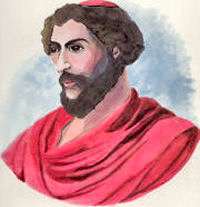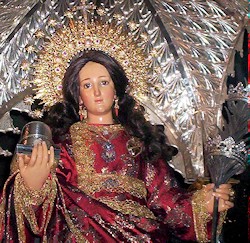
Daily Readings for:December 10, 2014
(Readings on USCCB website)
Collect: Almighty God, who command us to prepare the way for Christ the Lord, grant in your kindness, we pray, that no infirmity may weary us as we long for the comforting presence of our heavenly physician. Who lives and reigns with you in the unity of the Holy Spirit, one God, for ever and ever.
RECIPES
ACTIVITIES
o Advent Folksong: Maria Walks Amid the Thorn
PRAYERS
o Book of Blessings: Blessing Before and After Meals: Advent (2nd Plan)
o December Devotion: The Immaculate Conception
o Novena in Honor of Our Lady of Guadalupe
o Collect of the Mass of Pope St. Melchiades
o Christmas Anticipation Prayer
o Book of Blessings: Blessing Before and After Meals: Advent (1st Plan)
LIBRARY
o Ecclesia in Africa | Pope John Paul II
» Enjoy our Liturgical Seasons series of e-books!
Old Calendar: St. Melchiades, pope and martyr; St. Eulalia (Hist)
St. Melchiades "who suffered much during the persecution of Maximianus; when at last peace was restored to the Church, died in the Lord." He was an African whom St. Augustine calls "the true child of the peace of Jesus Christ." He ruled the Church of God in the last period of the Christian persecution from 311-314; hence the title of martyr is applied to him in a wider sense. His was the good fortune of witnessing the beginning of an era of peace, for in 312 the Emperor Constantine granted freedom to the Church. According to the the Extraordinary Form of the Roman Rite today is his feast.
Historically today is the feast of the martyr, St. Eulalia who was a native of Merida, in Spain.
St. Melchiades (also known as St. Miltiades)
Two popes had been exiled by Emperor Maxentius, and for nearly two more years the Church in Rome was steeped in turmoil, making it impossible to choose a pope. Finally Miltiades, an African, was elected. He had served as a priest under Marcellinus during the terrible Diocletian persecution. Now, however, he witnessed the effects of a kinder, more generous Roman government. Indeed, the Church would actually be favored with splendid gifts. By 311 the Church began to enjoy a peace resulting from a decree of toleration issued in both the East and the West. Emperor Maxentius ordered the properties of the Church restored. These included the land and buildings that had been confiscated during the reign of Emperor Diocletian. In 312 for the first time since the outbreak of persecution, a pope was able to preside over the celebration of Easter in full possession of the Church's holy assets.
Pope Miltiades worked diligently in a difficult time of transition. His edicts included forbidding the Christians to fast on Thursday and Sunday (the days during which the pagans kept their fasts) and directing that the Eucharist plate blessed by the bishop be carried to the various churches.
Constantine, having been proclaimed emperor in Gaul, now marched on Rome. The sign of the cross had been revealed to him in a vision where he was told that "by this sign shalt thou conquer." Constantine ordered his standards changed, and for the first time in history, the sign of peace was borne by an army. Constantine's legions defeated Maxentius, and the year 312 ushered in a new era, an era of peace; the Christians were truly set free. During the emperor's stay in Rome, the famous Lateran palace was given to Pope Miltiades by Fausta, Constantine's wife. The Lateran served as the papal residence for some four hundred years.
Less than a year later, a schism broke out in North Africa. Headed by a rigorist named Donatus, the faction objected to the policies of the bishop of Carthage, Caecilian. Bypassing the pope, they appealed directly to Constantine to intervene. The emperor, annoyed that he should be called on to settle disputes among the clergy, commissioned Miltiades and three other Gallic bishops to rectify the matter. The pope gathered fifteen additional bishops and held a synod in the great Lateran palace. The decision of this synod was to condemn Donatus and his party and to support the true bishop, Caecilian. The Donatists (as they later became called) appealed again to Constantine, but by the time another council could be called, Pope Miltiades had died.
St. Miltiades was an excellent pontiff who guided the Church wisely during a difficult time of changeover. Pope Miltiades was the last pope to be buried in a catacomb in the cemetery of Calixtus. His feast is celebrated December 10.
Excerpted from The Popes: A Papal History, J.V. Bartlett
St. Eulalia St. Eulalia descended from one of the most prominent families in Spain. She was educated in the Christian religion and was taught the sentiments of perfect piety. From her infancy she distinguished herself by an admirable sweetness of temper, modesty and devotion.
St. Eulalia descended from one of the most prominent families in Spain. She was educated in the Christian religion and was taught the sentiments of perfect piety. From her infancy she distinguished herself by an admirable sweetness of temper, modesty and devotion.
She showed a great love of the holy state of virginity, and by her seriousness and her contempt of dress, ornaments diversions and worldly company, she gave early signs of her sincere desire to lead a heavenly life on earth. Her heart was raised above the world before she was thought capable of knowing it, so that its amusements, which usually fill the minds of youth, had no charms for her, and every day of her life she continued to grow in virtue.
She was just twelve years old when the bloody edicts of the Emporer Diocletian were issued, by which it was ordered that all persons, without exception of age, sex, or profession, should be compelled to offer sacrifice to the gods of the empire.
Eulalia, although young, took the publication of this order as a sign of battle, but her mother, observing her impatient ardor for martyrdom, carried her into the country. However, the young saint quickly found a means to make her escape by night, and after much fatigue, arrived at Merida before daybreak.
That same morning, as soon as the court convined, she presented herself before the cruel judge, whose name was Dacian, and reproached him with impiety in attempting to destroy souls by compelling them to renounce the only true God.
The governor then commanded her to be seized. First, employing caresses, Dacian presented to her the advantages which her birth, youth and fortune gave her in the world, and the grief which her disobedience would bring to her parents. Seeing that these temptations had no effect, he began to threaten her, placing the most cruel instruments of torture before her eyes, saying to her, "All this you shall escape if you will but touch a little salt and frankincense with the tip of your finger."
Provoked at these seducing flatteries, she threw down the idol, trampled upon the cake which was laid for the sacrifice and spat at the judge -- an action only to be excused by her youth and inattention under the influence of a warm zeal, and fear of the snares which were laid before her.
Upon the judge's order, two executioners began to tear her tender sides with iron hooks, so as to leave the very bones bare. While this was happening, she called the strokes the trophies of Christ. Next, lighted torches were applied to her breasts and sides: under which torment, instead of groans, nothing was heard from her mouth but thanksgivings. The fire at length catching her hair, surrounded her head and face, and the saint was stifled by the smoke and flame.
History says that a white dove seemed to come out of her mouth, and to wing its way upward when the holy martyr expired: at which prodigy the executioners were so much terrified that they fled and left the body.
Her relics are kept with great veneration at Oviedo, where she is honored as patroness. The Roman Martyrology mentions her name on December 10.
Excerpted from Butler's Lives of the Saints
Things to Do:
- View this short YouTube video of the Fiesta of St. Eulalia in El Ramu, Spain to see how devotion to this saint is still celebrated.